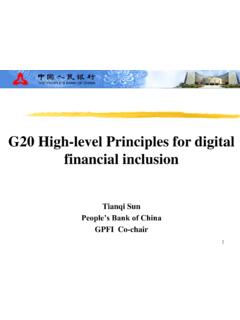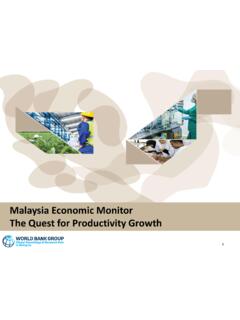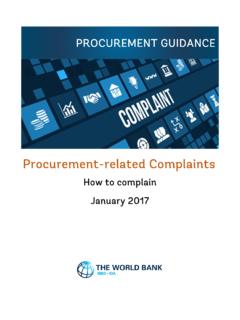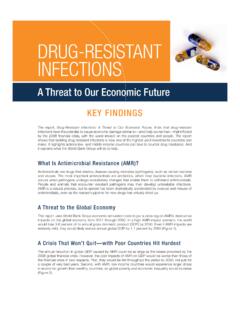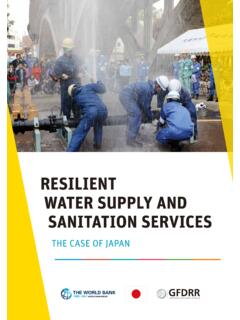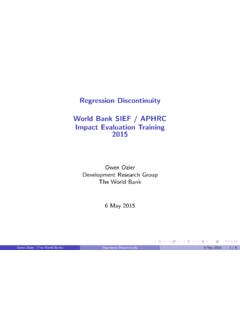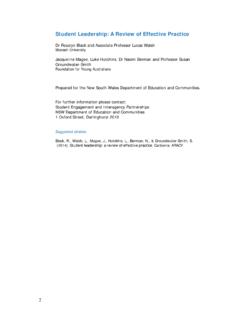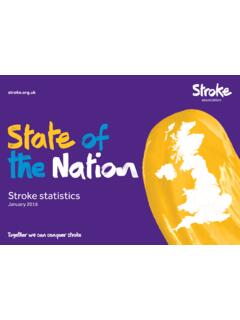Transcription of Bridging the Disability Divide through ... - World Bank
1 World development report BACKGROUND PAPER. digital Dividends Bridging the Disability Divide through digital technologies Deepti Samant Raja World Bank Group Bridging the Disability Divide through digital technologies Background Paper for the 2016 World Development Report: digital Dividends1. Deepti Samant Raja 1. The 2016 World Development Report (WDR) will explore the impact internet and digital technologies have on development. As the World Bank's flagship annual publication, the WDR is an influential guide to the economic, social, and environmental state of the World today. Learn more at 1. Contents Abstract .. 3. Introduction .. 3. Understanding the Disability Divide .. 5. The ICT opportunity for persons with disabilities .. 6. Multiple channels to access content and communicate .. 7. Availability and 9. There is an app for everything .. 10. ICT for inclusive development .. 11. Education and 11. Employment and income generation .. 14. E-governance and civic 16.
2 Financial inclusion .. 16. Disaster management .. 19. Challenges in the widespread use of accessible ICTs .. 20. Lack of enabling legal and regulatory frameworks .. 20. Stakeholder awareness, knowledge, and capacity .. 21. Concerns about cost and affordability .. 22. Strengthening the ecosystem for accessible ICTs .. 23. Improving legislation and policy .. 25. Technical assistance and awareness raising .. 26. Mainstreaming Disability for inclusive development .. 27. Conclusion .. 27. References .. 29. 2. Abstract The exclusion and marginalization of persons with disabilities is a human rights issue as well as an economic issue for countries. digital technologies break traditional barriers to communication, interaction, and access to information for persons with disabilities. The confluence of increasing public and private service provision through Information and Communication Technology (ICT). and the growing number of mainstream, everyday ICTs that can be used as accessible devices is changing the paradigm of technology-enabled development for persons with disabilities.
3 This paper provides an overview of the opportunities presented by the internet and ICT for the full participation of persons with disabilities. Accessible ICT can level the playing field for persons with disabilities across life domains including education, employment, e-governance and civic participation, financial inclusion, and disaster management. However, earlier divides may persist and new divides may be created when ICT-enabled development is not accessible to persons with disabilities, leading to an uneven distribution of benefits. This paper reviews the main challenges to the realization of ICT-enabled inclusive development and presents cost-beneficial policy and practice recommendations for governments and development practitioners. Introduction There is an often-cited quote by Mary Pat Radabaugh, formerly with the IBM National Support Center for Persons with Disabilities, that sums up the importance of technology in the empowerment of persons with disabilities (National Council on Disability 1993), For most people, technology makes things easier.
4 For people with disabilities, technology makes things possible. The exclusion and marginalization of persons with disabilities is a human rights issue as well as an economic issue for countries. When a significant section of society, estimated at 15 percent of the World 's population, faces obstacles in receiving an education, transitioning into the labor market, and becoming economically self-sufficient, it not only undermines their rights and dignity but adds significantly to a country's welfare burden (WHO and World Bank 2011). Information and Communication Technology (ICT) is increasingly enabling persons with disabilities to level the playing field in access to lifelong education, skills development, and employment (Broadband Commission for digital Development et al. 2013). The confluence of two major trends is reshaping the paradigm on using technology to promote inclusion and full participation of persons with disabilities. The first is that the Internet and Information and Communication Technology (ICT) are becoming common and popular channels for the delivery and implementation of governance, welfare, socioeconomic development, and human rights programming (Samant, Matter, and Harniss 2012).
5 They are transforming pathways to poverty reduction by enabling direct interactions between producers and markets globally, new methods of delivering personalized public and social services quickly, different channels for income generation, and innovations in asset accumulation and 3. access to finance (Omole 2013; Spence and Smith 2010). The internet also enables multiple channels to access and contribute information, with a global reach, which can improve transparency, accountability, and monitoring of development programs and services. Multiple delivery channels are being used for communication and service delivery including email, text messaging, voice communications, and video. The second is that a growing number of mainstream, everyday ICT such as mobile devices and desktop computers increasingly offer functionalities that facilitate communication and information access for persons with disabilities. Features such as text-to-speech and voice recognition, ability to change contrast and color schemes, touch and gesture input, and screen magnification which in the past required specialized standalone software and hardware are embedded within off-the-shelf ICT devices.
6 digital technologies enable persons with disabilities to receive information and content in the format that they can perceive and prefer. For example, a person with visual impairments can use speech-to-text functionality or software to read a website, a person with hearing impairments can use SMS or instant text messaging to communicate, and a person with mobility impairments can use voice recognition to operate and navigate their digital device. This presents an important opportunity to break the traditional barriers of communication and interaction that persons with disabilities face and which hinder their full participation in society. A recent survey of 150 experts from over 55 countries ranked websites and mobile devices and services as the technologies that can contribute the most to the social and economic inclusion of persons with disabilities (Broadband Commission for digital Development et al. 2013). The experts also perceived the highest impact of ICT for individuals with disabilities to be on independent living, employment, education, and access to government services.
7 However, the advancements in technology are insufficient by themselves to bridge the gaps in the socioeconomic inclusion of persons with disabilities. The adaptation, operationalization, and implementation of ICT for inclusive development remains dependent on others factors within the ecosystem (Samant, Matter, and Harniss 2012). Existing evidence shows that the success of using the internet and ICT for the inclusion of persons with disabilities is heavily impacted by stakeholders' knowledge and awareness of the ICT solutions available, laws and policies, and the capacity of various stakeholders to support accessible ICT services (Samant, Matter, and Harniss 2012). In fact, the use of the internet and ICT can widen the disparities between persons with and without disabilities if they are not designed to be accessible and inclusive. This paper provides an overview of the opportunities presented by the internet and ICT for the full participation of persons with disabilities.
8 Accessible ICT can level the playing field for persons with disabilities across life domains including education, employment, e-governance and civic participation, financial inclusion, and disaster management. However, earlier divides may persist and new divides may be created when ICT-enabled development is not accessible to persons with disabilities, leading to an uneven distribution of benefits. The paper also reviews the main 4. challenges to the realization of ICT-enabled inclusive development and presents cost-beneficial policy and practice recommendations for governments and development practitioners. Understanding the Disability Divide Over a billion people globally, approximately 15 percent of the World 's population, have disabilities and 80 percent of them live in developing countries (WHO and World Bank 2011). Individuals can experience different types of disabilities including visual, hearing, speech, mobility, cognitive, and psychosocial.
9 Individuals also experience the onset of disabilities as they age. Almost 12 percent of the World 's population is over the age of 60; that figure will be over 20. percent by 2050 (UN Department of Social and Economic Affairs 2013). Children with disabilities attend and complete primary and secondary education at lower rates than children without disabilities (UNICEF 2013), and the gaps are as high as 40 to 60 percent in low and middle income countries such as Cambodia, Bolivia, and Indonesia (WHO and World Bank 2011). Estimates suggest that almost a third of the children who do not receive a primary education have disabilities (Human Rights Watch 2012). This further limits their opportunities for employment as they transition to adulthood. The employment rates of persons with disabilities are a third to half of the rates for persons without disabilities, with unemployment rates as high as 80 to 90 percent in some countries (including developed and developing economies) (Mizunoya and Mitra 2012; UN Enable, ).
10 Individuals with disabilities also face higher rates of multidimensional poverty as compared to persons without disabilities (Mitra, Posarac, and Vick 2013). The relationship between income and Disability can be complex, and gaps in the economic well-being of persons with and without disabilities can be significantly higher in middle income countries than low income countries (Mitra, Posarac, and Vick 2013). Lower educational attainment and lower productivity in a workplace that is not adapted to be accessible impacts the earning potential of an individual with a Disability and results in wage disparity as compared to individuals without disabilities (Longhi, Nicoletti, and Platt 2010). A high unemployment rate for persons with disabilities increases a country's expenditure on welfare which is in fact counter-productive to their social inclusion and economic self-sufficiency (Burkhauser and Daly 2011; Etherington and Ingold 2012; OECD 2010). Ripple effects can also impact the earning capacity of other household members, mostly women, who serve as primary caregivers for children and youth that are unable to go to school.

